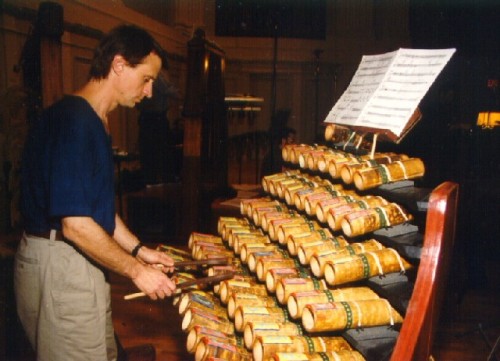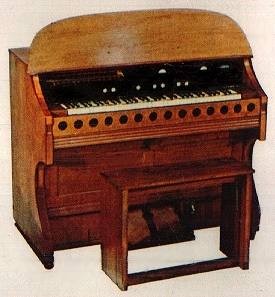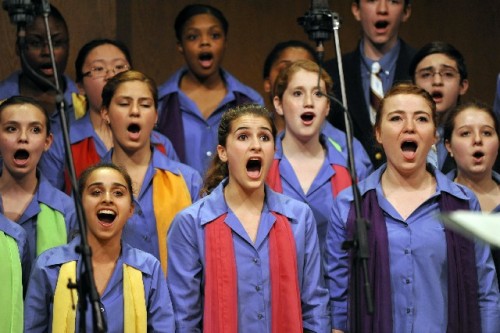Michael Tilson Thomas Continues with His Mavericks
Carnegie Hall Hosts Partch, Bates, Del Tredici and Harrison
By: Susan Hall - Apr 01, 2012
Michael Tilson Thomas
American Mavericks
Members of the San Francisco Symphony Newband
Dean Drummond and Stefan Starin, Directors
Young People’s Chorus of New York City
Francisco J. Nunez, Director
Donato Cabrera, Conductor
Kiera Duffy, Soprano
Paul Jacobs, Organ
Mason Bates, Electronics
Harry Partch, Daphne of the Dunes
Mason Bates, Mass Transmission
David Del Tredici, Syzygy
Lou Harrison, Concerto for the Organ with Percussion Orchestra
Zankel Hall at Carnegie
March 29, 2012
"It was as if one had drunk the music instead of accepting it through the ears…The affinity of his music with water, with the poetry of space, with fusion appealed to me,” erotic diarist Anaïs Nin wrote referring to the music of Harry Partch. When you see the film Windsong, whose score became Daphne in the Dunes, performed first on the program at the American Mavericks program at Zankel Hall, you can see that Anais Nin is right. This is music you drink and float in. Today Partch’s descendants are in Iceland and with Nico Muhly.
Every instrument in Windsong was played by Partch himself for the film track. One instrument was then laid over the other as the score required. Partch had not set out to be a carpenter, but like other modern mavericks, he often made instruments to create a timbre he wanted. His instruments look like beautifully-crafted objects in an American Craftsman store.
A gourd tree, the Boo, Cloud Chamber Bowls catch the eye and arrest the ear as they careern around, hit by the hand, gloved and nude, and mallets with heads ranging from small wooden to big, fat and furry. Looking cool in their shirts and jeans, members of the San Francisco Symphony’s Newband appeared to enjoy themselves, even following Partch's admonition to pay attention to good footwork. You could see why Partch called his music corporeal.
Young composer Mason Bates was onstage performing percussion on computer for his Mass Transmission. Scored for organ, electronica, soprano and alto soloists. Bates performed muffled sounds that sometimes exploded on his computer keyboard. Paul Jacobs on the organ drew out sounds suffused with light, and unrestrained. Effects were often tinged with gamelan-like tones.
Listening to the piece was like listening to a church mass. Attention to the words was important. The Young People's Chorus of New York guided by Donato Cabrera, were wonderful. Marching in with their folded stools, and then standing extra tall, they are the 'backbone' of the piece.
Fortuitously Bates found transmissions between the Dutch parents of children sent to be pages in Java, a colony held by Holland early in the 20th century. Fascinated by the process of communication, Bates severed two chorus members, sending them to the balcony to perform their solos as far apart as possible in the Hall. All expression was surely shaped to the composer’s ends.
In David Del Tredici’s Syzygy, a tolling bell swinging somewhere in dark orbit is the primary theme, but Syzygy, wonderful as the word is, means a straight line configuration of three celestial bodies. It sounds like a word that Jung would weight in on, and he did; a divine coupling of the animus and the anima. Tilson Thomas introduced Del Tredici as a very young 75. Del Tredici entered the hall like a performance artist, chained to his companion as Jung’s animus and anima might be bound.
Syzygy, led by Kiera Duffy, a soprano and Nicole Cash on the horn, is set to two contrasting poems by James Joyce, one in very tight and primeval, the other expanding out into the universe. The performers soared.
Concerto For Organ with Percussion Orchestra was Lou Harrison’s response to a request from two colleagues at San Jose State. An organist and percussionist wanted to work together. Palm and arm clusters Harrison learned from Henry Cowell are included with gamelan sounds.
Harrison could not tune an organ to the American gamelan so he created a quasi-gamelan from pitched percussion instruments of piano, celesta, glockenspiel, vibraphone, tubular chimes, and a set of large-tuned gas-cyclinder bells made by his partner and frequent collaborator, Bill Colvig. Harrison was determined not fall into what he called ‘the Stravinsky syndrome’—the bassoon playing the top and the flute the lowest. He had instruments specially made to create this and any other special effect.
As performed at Zankel, the instrumentation fell naturally into three groups—the organ, pitched percussion, non-pitched plumber’s pipes, three muted gongs, a large rasp, three high suspending gongs, snare drum, small Chinese crash cymbals, a suspended cymbal, maracas, three temple blocks, three tom-toms, three low suspended gongs, a suspended contrabass drum, and three wooden drums. A wow for the ears.
Harrison completed the circle of this marvelous maverick evening performance when he wrote of his friend Partch: he “made his lovely life’s music Entirely trued in ratios… Thus we compose continuance from his start” as he “joins together our brains and ears, flesh.”
In bringing his American Mavericks to New York, Tilson Thomas has joined together senses we sometimes forget. What a treat American Mavericks are.





